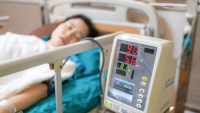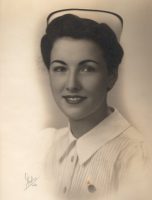This case presentation illustrates ALS progression and accompanying care.
Takeaways:
- Amyotrophic lateral sclerosis care focuses primarily on palliation.
- Nurses must know how to identify symptoms, recommend treatment, coordinate care, and educate patients and families.
- An interprofessional team is essential in providing adequate care and comfort to patients and families.
Amyotrophic lateral sclerosis (ALS), a progressive neurodegenerative disease whose pathophysiology isn’t understood, results in upper and lower motor neuron dysfunction. This neural damage leads to muscular atrophy, spasms, and fasciculations (involuntary muscle contractions). Muscle dysfunction begins in one body region then becomes more generalized as the disease progresses, eventually leading to respiratory muscle compromise. Death from ALS respiratory failure typically occurs between 2 to 5 years after symptom onset. (See ALS stats.)
ALS stats
Amyotrophic lateral sclerosis (ALS) affects people of all races, ethnicities, and genders.
- The incidence rate is 2 per 100,000 people.
- Symptom onset typically begins between ages 55 and 75 years.
- Approximately 90% of ALS cases are sporadic (no environmental or genetic cause).
- Only 10% of ALS cases are classified as familial or genetic.
- Most people with ALS have initial symptoms localized to unilateral limbs and are classified as having limb-onset ALS (70%).
- Those with initial speech and swallowing symptoms are classified as having bulbar-onset ALS (25%).
- Truncal-onset ALS is rare and may begin with the respiratory muscles (5%).
Symptom pattern variations and unknown causes make ALS difficult to identify and treat, and the low incidence rate means that most nurses don’t commonly see patients with the disease. A better grasp of clinical manifestations and diagnostic testing may lead to earlier diagnosis and treatment. Nurses can lead this effort by increasing their knowledge of symptom presentation, pharmacologic therapies, and interprofessional interventions.
The following case presentation illustrates disease onset, diagnosis, treatment, and interprofessional care.
Case presentation
Kiran Singh* is a 73-year-old South Asian cis-man. A retired electrical engineer, he’s married with two adult children living out of state. Mr. Singh, who’s 5’ 9”, weighs 138 pounds. His past medical history includes coronary artery disease with three stents, chronic obstructive pulmonary disease, immunoglobulin A nephropathy (in remission), hypertension, hyperlipidemia, and heart failure.
Initially, Mr. Singh visits his primary care provider because of frequent bilateral lower leg cramps. He describes the cramps as sudden, causing such severe pain that he can’t walk. They resolve after 15 to 20 minutes. He says that calf massage and acetaminophen help slightly with the pain. Lab tests show that Mr. Singh’s potassium levels are slightly below normal. The provider prescribes oral potassium supplements and recommends that Mr. Singh stay hydrated.
Four years later Mr. Singh has increasing, intermittent lower leg cramping that’s worse on the left side. He notices that his left leg is much weaker than his right and uses a cane to walk. In addition, Mr. Singh is losing weight; he now weighs 125 pounds. Because Mrs. Singh is his main caretaker, a housekeeper found through elder care services performs light housework and prepares meals. Mr. Singh still drives to local destinations, but his family encourages him to stop. His primary care provider refers him to a neurologist.
The neurologist orders a series of tests, which rule out infection, cancer, and peripheral arterial disease. Pulmonary function tests show that Mr. Singh’s forced vital capacity is 75% (normal is 80% to 120%). Blood tests indicate high levels of creatinine kinase (CK), and autoantibody tests are inconclusive. A biopsy of the muscle in Mr. Singh’s left calf reveals intramuscular inflammation, with muscle atrophy and degenerative changes. Without a definitive diagnosis, the neurologist refers the patient to a neuromuscular specialist.
By the time Mr. Singh meets with the neuromuscular specialist, the grip strength in his left hand has grown weaker, he’s walking more slowly with a walker, and his voice is softer and slightly slurred when he’s tired. His appetite is good, but he now weighs 115 pounds. He also reports shortness of breath with exertion. The specialist’s physical examination shows clear muscular atrophy of the left leg and hand compared to the right. To confirm a diagnosis, the specialist orders nerve conduction studies and an electromyography (EMG). The EMG shows abnormal results, including spontaneous electrical activity of the muscles even at rest. After reviewing Mr. Singh’s history, progression, lab work, and abnormal EMG, the specialist confirms a diagnosis of lower motor neuron ALS.
Diagnosis
Disease onset variations and initial signs and symptoms that mimic other neurodegenerative diseases make ALS diagnosis difficult. No single diagnostic test exists, so diagnosis is by exclusion. A thorough history and physical exam must be performed, and lab work, lumbar puncture, and urinalysis help rule out other conditions. Pulmonary function tests to measure lung volume, vital capacity, air flow, and gas exchange also should be conducted. If the provider suspects neuromuscular disease, a muscle biopsy may be ordered. Conduction studies and EMG can test for abnormal electrical activity of the muscles, resulting in a more definitive diagnosis. (See Diagnosing ALS.)
Diagnosing ALS
Amyotrophic lateral sclerosis (ALS) is a diagnosis of exclusion. In addition to family and health histories, the following exams and tests help rule out other conditions.
Physical exam
During the physical exam, look for the following:
- Dysphagia
- Emotional lability
- Rigid muscles
- Slurred speech
- Unilateral muscle weakness and atrophy
Laboratory tests
- Autoantibodies
- Basic metabolic panel
- B12 level
- Complete blood cell count
- Creatinine kinase
- Heavy metals panel
- Hepatitis
- HIV (enzyme immunoassay and Western blot)
- Lumbar puncture
- Parathyroid hormone level
- Thyroid hormone level
- Thyroid-stimulating hormone level
- Urinalysis
- White blood cell count
Diagnostic tests
- Computed tomography scan
- Electromyography
- Magnetic resonance imaging
- Muscle Biopsy
- Nerve conduction
- Pulmonary function
Mr. Singh’s elevated CK (due to muscle atrophy), initial left leg muscle wasting and dysfunction, as well as significant weight loss, all indicate a possible lower motor neuron ALS diagnosis. Because the muscle biopsy and autoantibody tests aren’t definitive, inflammatory and autoimmune diseases seem unlikely. Only after the EMG, which shows that the left calf muscles don’t respond normally to electrical stimulus, does the provider diagnose ALS.
Treatment
Because no cure for ALS exists, treatment focuses on slowing disease progression and managing symptoms. The only approved medications to slow disease progression are riluzole (taken orally) and edaravone (administered via infusion). Riluzole is thought to work by blocking the release and uptake of glutamate, a neurotransmitter that may cause increased production of astrocytes that harm motor neurons. Edaravone, an antioxidant, is thought to act as a neuroprotective agent by relieving the effects of oxidative stress on motor neurons. Route of administration and cost frequently are the deciding factors for patients. Riluzole costs up to $200 per month even with insurance coverage. Edaravone, which is administered in 2-week cycles, costs $145,500 per month out-of-pocket, with varying insurance coverage.
Most ALS treatment focuses on symptom management. Weight loss and dysphagia are addressed with dietary changes and occupational therapy. Percutaneous endoscopic gastrostomy (PEG) tubes may be recommended to supplement nutritional needs. Studies suggest that ALS in patients who are malnourished progresses faster than in those of normal weight or who are slightly overweight. Dyspnea can be treated symptomatically with morphine, but also with noninvasive ventilation (such as bi-level positive airway pressure [BiPap]), cough assist machines, and suction. Noninvasive ventilation has been shown to decrease exertion and slightly increase patient lifespan. (See Pharmacologic symptom treatment.)
Pharmacologic symptom treatment
In addition to prescribing riluzole or edaravone to slow amyotrophic lateral sclerosis progression, providers may prescribe the following medications to manage symptoms.
| Medication | Symptom |
| Acetaminophen | · Fever · Mild-to-moderate pain |
| Antibiotics | · Pneumonia · Urinary tract infections |
| Anticholinergics · Glycopyrrolate | · Secretions (to dry them up) · Upper respiratory congestion |
| Antispasmodics · Tolterodine tartrate | · Bladder spasms |
| Benzodiazepines · Diazepam · Lorazepam | · Anxiety · Insomnia · Muscle spasms |
| Eugeroics · Modafinil | · Fatigue |
| Expectorants · Enemas · Guaifenesin | · Congestion · Secretions (to thin them) |
| · Laxatives · Suppositories
| · Constipation |
| Neurotoxin · Botulinum toxin type A | · Severe muscle spasms |
| Non-steroidal anti-inflammatory drugs · Ibuprofen | · Fever · Mild-to-moderate pain |
| Opioids · Morphine | · Dyspnea · Moderate-to-severe pain |
| Sedatives · Zolpidem | · Insomnia |
| Skeletal muscle relaxants · Baclofen | · Muscle spasms |
| Topical · Pramoxine-zinc oxide | · Pressure injuries |
Life with ALS
After his ALS diagnosis, Mr. Singh starts receiving care from a neurology specialist at an ALS clinic. He’s diagnosed with mild-to-moderate stage ALS and starts taking riluzole. Mr. Singh goes to the ALS clinic every 10 to 12 weeks and meets with an interprofessional treatment team (neurologist, palliative care provider, nurse case manager, physical therapist, occupational therapist, speech therapist, respiratory therapist, registered dietician, and social worker). He receives physical, occupational, and speech therapy at home, and the social worker refers him to the local ALS Association chapter for support. Mr. Singh also is offered aide services, but he declines them because he’s still able to bathe himself with his wife’s help.
The case manager coordinates services and equipment (including a wheelchair and commode) delivery for Mr. Singh. The family attends team meetings together via Zoom, and Mrs. Singh and their children advocate for Mr. Singh.
Initially, Mr. Singh wants to try edaravone infusions to slow ALS progression and prolong his life. With some difficulty, the case manager receives insurance approval. However, the clinical protocol requires Mr. Singh to receive infusions in the clinic every day for 2 weeks before starting home infusions. Trips back and forth to the clinic have become difficult for the patient, so after speaking with the specialist and palliative care provider, he decides not to start edaravone treatment. Instead, he opts to preserve his quality of life and comfort.
Mr. Singh continues riluzole but the disease progresses swiftly. His voice weakens and he begins to experience dysphagia and increased dyspnea. After the speech therapist conducts a swallow study, the dietician recommends that Mr. Singh’s food be pureed and that he supplements his meals with Ensure. Pulmonary function tests show that the patient’s forced vital capacity has dropped to 60%. The neurology specialist orders BiPap, cough assist, and suction machines. The respiratory therapist teaches Mr. and Mrs. Singh how to use them.
The team is concerned with the patient’s rapid weight loss. They speak with him about his diet and possible PEG tube placement. As a devout Hindu and strict vegetarian, Mr. Singh declines the PEG tube. He says he still has a good appetite and doesn’t want such an invasive intervention. However, the team dietician and his daughters urge him to relax his dietary restrictions to increase his caloric intake, which he agrees to. Mr. Singh had restricted his salt and fat intake to manage his hypertension and cardiac disease, but now that he has advancing ALS, he must consume as many calories as possible.
While reviewing advance directives, Mr. Singh tells the neurology specialist that he wants a full code, with all resuscitative measures, and he makes Mrs. Singh his healthcare proxy. The Singh daughters voice concern about making Mrs. Singh healthcare proxy because she has difficulty expressing herself in English, but Mr. Singh insists. Driving also is addressed. Mr. Singh feels that his independence is being taken away but recognizes the safety issues. He agrees to give up driving.
Mr. Singh can still ambulate with a walker, but only for short distances and with great effort. He’s also still continent but is using urinals and can only walk to the bathroom with help from a family member or aide. Observing the patient’s sharp decline and advanced symptoms, the neurology specialist and palliative care provider recommend hospice services. Although reluctant at first, with family support and education, Mr. Singh agrees.
End-of-life care
Three weeks after starting hospice services, while Mr. Singh is having tea with his wife, he feels a sudden urge to urinate. When he reaches for his urinal, he falls to the floor and hits his head. He doesn’t lose consciousness, but he sustains a laceration and a black eye. In addition, Mr. Singh becomes extremely short of breath with any effort, so the provider prescribes low-dose morphine to decrease dyspnea.
Mr. Singh begins to have bouts of severe constipation, a common occurrence among ALS patients. He’s anxious about this and follows a strict bowel regimen, taking laxatives and stool softeners daily. Suppositories and enemas are administered if no bowel movement occurs. Eventually, constipation becomes such an issue that the hospice nurses must dis-impact the patient weekly.
Fortunately, Mr. Singh has only infrequent complaints of pain, most of which are caused by hemorrhoids and anal fissures resulting from constipation. They’re treated with pramoxine-zinc oxide and morphine. Occasionally, Mr. Singh reports intermittent back and leg pain, which is relieved with repositioning.
After his fall, Mr. Singh becomes bed- and chairbound and dependent for all activities of daily living. He begins to develop Stage 1 pressure injuries on his coccyx, which the hospice nurses treat with pramoxine-zinc oxide. To prevent further skin breakdown, the hospice nurse orders a hospital bed with an alternating pressure air mattress and a manual hydraulic lift. The local ALS association loans Mr. Singh a powered wheelchair.
To help the family cope with the increased care, the social worker recommends an in-home health agency to provide aides 8 hours a day, 5 days a week. The aides help to reposition Mr. Singh every few hours, bath and change him, and perform light housekeeping and laundry. They use a gait belt to help the patient stand and pivot to his wheelchair.
Mr. Singh can no longer feed himself, so his wife purees his food and feeds him. Thickened fluids allow him to drink by himself with a straw. Despite the risk for aspiration related to increasing dysphagia, Mr. Singh chooses to keep eating and drinking for comfort and continues to refuse the PEG tube.
Psychosocial and spiritual issues become more important to Mr. Singh. Confined to a hospital bed, he’s anxious and depressed, and he’s embarrassed that others are bathing, cleaning, and feeding him. Mr. Singh is religious and stoic, rarely talking about his emotions. However, he begins sharing his concerns and end-of-life wishes with his daughters and the hospice social worker. When offered hospice chaplaincy services, he declines. The social worker contacts Mr. Singh’s Hindu priest, who provides spiritual support.
Eventually, Mr. Singh asks one of his daughters if God will forgive him if he can’t perform his usual religious observances. He says he’s afraid and doesn’t want to suffer. His daughter reassures him that God will forgive him, and that she and her sister will take care of their mother and look after his affairs. She also assures him that they understood his wishes and will carry them out.
Thus comforted, Mr. Singh meets with the hospice team and his family and makes his daughters his healthcare proxies. He provides detailed guidance for his family on the Hindu funeral rites he wants performed, and he changes his code status, opting not to be resuscitated, intubated, or taken to the hospital. Mr. Singh declines I.V. therapies and artificial feeding. The provider prescribes lorazepam for anxiety and insomnia, which helps the patient sleep.
Outcome
Mr. Singh’s ALS progresses rapidly. Nine months after his diagnosis, he aspirates and becomes less responsive and eventually comatose. He dies a day later in his home with hospice services.
Be a strong advocate
ALS care, which primarily focuses on palliation and helping patients adapt to physical changes, requires a wide range of resources and detailed coordination. Nurses play a critical role in identifying symptoms, making treatment recommendations, coordinating care, and educating patients and families. Nurse-led interprofessional care is essential for patient comfort and should begin as early as possible after diagnosis to ensure appropriate physical, psychosocial, and spiritual support. Local ALS associations also can provide support, equipment, and other resources.
Ongoing culturally sensitive conversations with patients and families about quality of life and advanced directives can help ensure treatment options and the patient’s wishes are periodically reviewed as the disease progresses. As seen in this case presentation, code status, treatment choices, and psychosocial and spiritual needs can change throughout the course of the disease. With increased education and awareness, nurses can serve as strong advocates and leaders on interprofessional teams caring for patients with ALS.
*Names are fictitious.
ALS resources and equipment
Caring for patients with amyotrophic lateral sclerosis (ALS) requires a variety of equipment and resources.
| ALS symptoms | Recommended durable medical equipment | Suggested interprofessional care | ALS complications |
| Motor · Ambulation difficulty · Loss of grip strength (initially one-sided, then progressive · Muscle weakness and wasting (initially one-sided, then progressive)
| · Adaptive equipment (for dressing, feeding, etc.) · Bedside table · Cane/walker/wheelchair · Commode · Gait belt · Grab bars · Powered wheelchair · Shower chair · Splints/orthotics · Urinal/bedpan | · Chaplaincy · Home health aides · Hospice care team · Housekeeper · Neurology provider/ALS clinic · Nursing · Occupational therapist · Palliative care team · Physical therapist · Registered dietician · Respiratory therapist · Social worker · Speech therapist
| · Activities of daily living · Anxiety · Aspiration pneumonia · Depression · Falls · Nutritional compromise · Pain · Respiratory compromise · Skin compromise · Spiritual unrest · Ventilator-associated pneumonia |
| Respiratory · Decreased vital capacity · Dysarthria · Dyspnea · Inability to cough effectively · Respiratory failure | · BiPap/CPap machine · Cough assist machine · Hospital bed · Mechanical ventilation · Suction machine · Voice banking/communication device | ||
| Weight loss · Anorexia · Cachexia · Dysphagia | · Ensure or other dietary supplement · Gastronomy tube · Liquid thickeners
| ||
| Skin · Pressure injuries | · Hospital bed with air mattress · Manual hydraulic lift with sling · Wound care supplies |
BiPap = bilevel positive airway pressure, CPap = continuous positive airway pressure
Kaveri M. Roy is a distinguished teaching assistant professor and TEAL Fellow at the MGH Institute of Health Professions in Boston, Massachusetts.
References
ALS Association. Understanding ALS. als.org/understanding-als
ALS News Today. Diagnosis of ALS. alsnewstoday.com/als-diagnosis
Bello-Haas VD. Physical therapy for individuals with amyotrophic lateral sclerosis: Current insights. Degener Neurol Neuromuscl Dis. 2018;8:45-54. doi:10.2147/DNND.S146949
Burgos R, Bretón I, Cereda E, et. al. ESPEN guideline clinical nutrition in neurology. Clin Nutr. 2018;37(1):354-96. doi:10.1016/j.clnu.2017.09.003
Hogden A, Foley G, Henderson RD, James N, Aoun SM. Amyotrophic lateral sclerosis: Improving care with a multidisciplinary approach. J Multidiscip Healthc. 2017;10:205-15. doi:10.2147/JMDH.S134992
Larson TC, Kaye W, Mehta P, Horton DK. Amyotrophic lateral sclerosis mortality in the United States, 2011-2014. Neuroepidemiology. 2018;51(1-2):96-103. doi:10.1159/000488891
Long R, Havics B, Zembillas M, Kelly J, Amundson M. Elucidating the end-of-life experience of persons with amyotrophic lateral sclerosis. Holist Nurs Pract. 2019;33(1):3-8. doi:10.1097/HNP.0000000000000301
Majmudar S, Wu J, Paganoni S. Rehabilitation in amyotrophic lateral sclerosis: Why it matters. Muscle Nerve. 2014;50(1):4-13. doi:10.1002/mus.24202
Mazón M, Vázquez Costa JF, Ten-Esteve A, Martí-Bonmatí L. Imaging biomarkers for the diagnosis and prognosis of neurodegenerative diseases. The example of amyotrophic lateral sclerosis. Front Neurosci. 2018;12:784. doi:10.3389/fnins.2018.00784
Roy KM. Frequently asked questions about palliative care. Am Nurse Today.2020;15(7). myamericannurse.com/frequently-asked-questions-about-palliative-care
Sanchez B, Rutkove SB. Electrical impedance myography and its applications in neuromuscular disorders. Neurotherapeutics. 2017;14(1):107-18. doi:10.1007/s13311-016-0491-x
Schultz J. Disease-modifying treatment of amyotrophic lateral sclerosis. Am J Manag Care. 2018;24(15 suppl):S327-35.
Vacca VM. Amyotrophic lateral sclerosis: Nursing care and considerations. Nursing. 2020;50(6):32-9. doi:10.1097/01.nurse.0000662348.31823.44



















1 Comment. Leave new
The timing of this article is fantastic. I had a former coworker just pass from this devastating disease end of December 2021. She had only been diagnosed for about a year I think. I pray they find a cure for this soon.